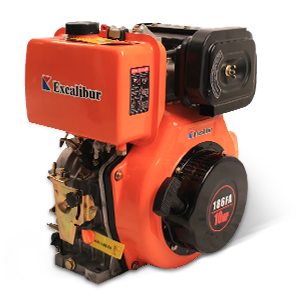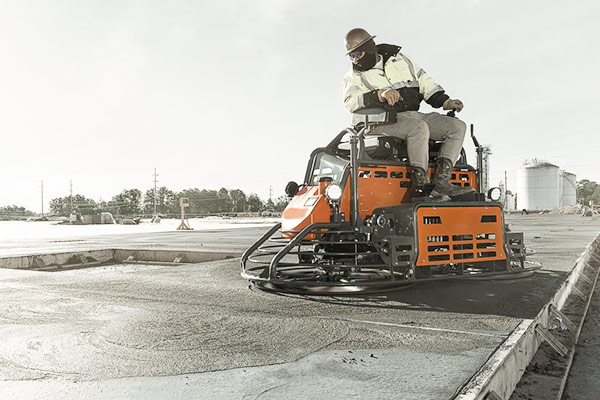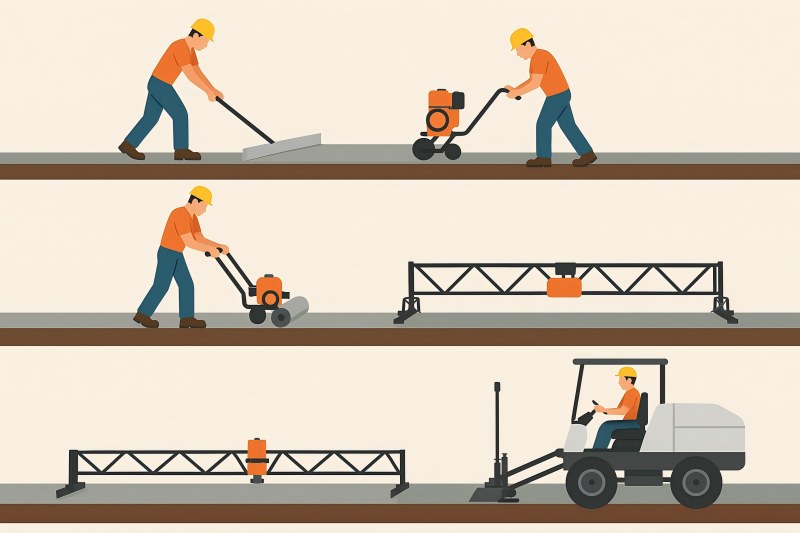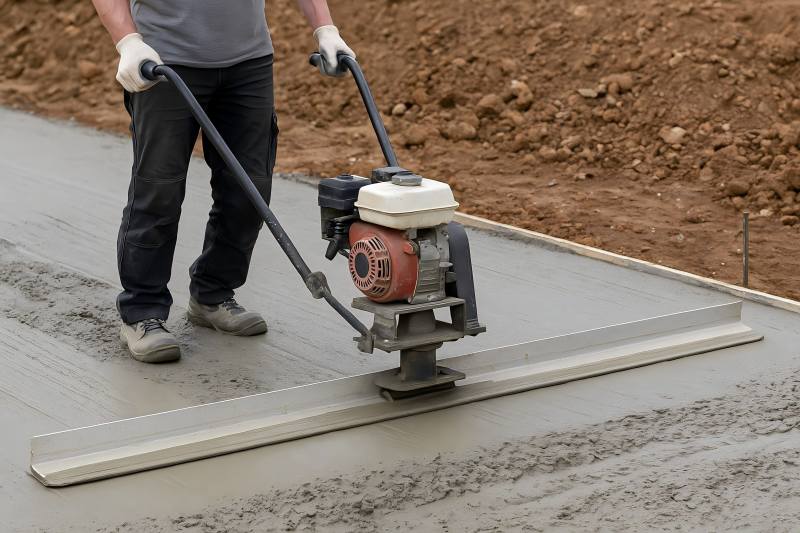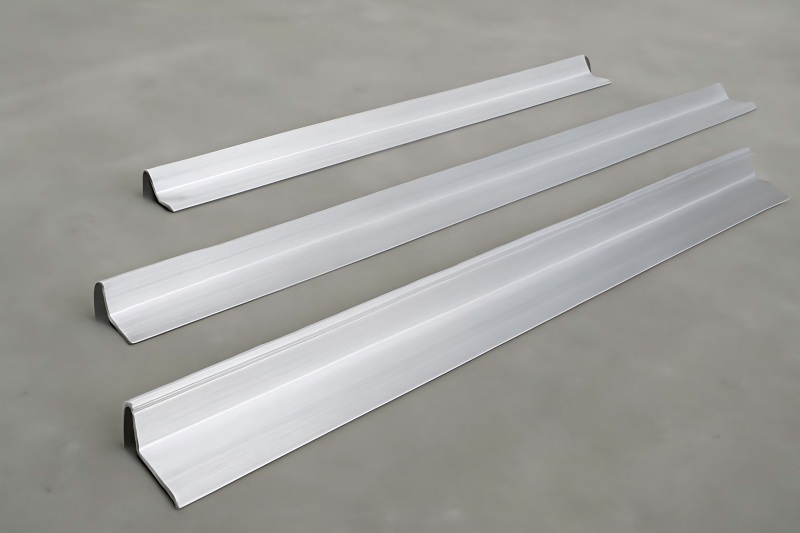Ride-on power trowels are the workhorses of modern slab finishing. When you’re chasing flatness numbers, battling deadlines, and working across thousands of square feet, the right machine can shave hours off the schedule, reduce crew fatigue, and materially improve FF/FL results.
What a Ride-On Trowel Actually Does
A ride-on trowel consolidates, densifies, and smooths the surface of fresh concrete using two counter-rotating rotors (most common) or one large rotor (less common). Operators start with pans for floating to embed aggregate and close voids, then switch to finish blades for sealing and polishing. On big floors, the time window between “too wet” and “too hard” is short. Machine speed, coverage width, maneuverability, and blade pressure determine whether you finish on time—or chase burn lines all night.
Core outcomes you’re buying:
- Throughput: square feet (or m²) per hour per machine/crew
- Flatness: ability to hit FF/FL targets with fewer corrective passes
- Consistency: uniform sheen and edge-to-edge density
- Cost control: lower labor per square foot and reduced rework
What They Mean in Practice
Rotor Diameter & Count
- Common configs: dual 36″, dual 46″ (most prevalent), and heavy-duty 60″+ class.
- Impact: Larger diameter = fewer lanes for a given slab = higher throughput. But bigger machines are heavier and need more open space and straighter runs.
Drive Type: Mechanical vs. Hydrostatic
- Mechanical: Direct belts/gearbox. Lighter upfront cost, good feedback, fewer hydraulic components.
- Hydrostatic: Smooth, precise control, variable speed, excellent for high-FF finishing and tight maneuvering; typically higher purchase price and maintenance skill requirements.
Power & Fuel
- Gasoline: Common, lighter, widely available.
- Diesel: More torque for big rotors and long shifts; heavier; emissions considerations (especially indoors).
- LPG (Propane): Cleaner emissions for enclosed spaces; logistics for fuel swaps.
- Horsepower: Typical ride-on range 20–80+ hp depending on class.
Blade/Pan System
- Pans: 10- or 11-gauge pans, 5- or 6-lug patterns.
- Finish blades: 4/5/6-blade spiders; larger finishing area raises production but needs adequate horsepower.
Speed & Pitch Control
- Rotor speed: ~60–165 rpm typical. Higher top speed helps sealing; low-speed torque helps float phase.
- Pitch control: Manual levers or electric/hydraulic; repeatability matters for FF/FL.
Weight & Down Pressure
Heavier machines can achieve better densification and faster sealing if the concrete is ready; they also sink if you jump the gun. Balance weight with slump/bleed characteristics and ambient weather.
Ergonomics & Safety
Suspension seat, low-effort controls, LED lighting for night pours, deadman shutdown, cage and guarding, E-stop, and backup alarms.
Maintenance Access
Pan/blade swap speed, belt/hydraulic service points, filters, and diagnostics. The best machine is the one your crew keeps in spec.

How Big a Trowel Do You Need?
Below are typical production rates on open floors with experienced operators and a well-planned pour. Your actual rates depend on mix design, set times, crew size, pass count, and site constraints.
- Dual 36″ class: ~6,000–9,000 ft²/hr (560–830 m²/hr) during float phase; finishing ~4,000–6,000 ft²/hr (370–560 m²/hr)
- Dual 46″ class: ~8,500–12,000 ft²/hr (790–1,115 m²/hr) float; finishing ~5,500–8,000 ft²/hr (510–740 m²/hr)
- Heavy 60″+ class: ~10,000–14,000+ ft²/hr (930–1,300+ m²/hr) float; finishing ~7,000–10,000 ft²/hr (650–930 m²/hr)
- Rule-of-thumb: One dual-46″ ride-on plus one 36″ support machine per ~20,000–30,000 ft² (1,850–2,800 m²) placement window is a common starting point for distribution centers and big-box retail slabs.
Quick Selection Matrix
| Project Type | Slab Size per Pour | Flatness Target (FF/FL) | Obstacles/Columns | Recommended Drive | Rotor Class | Power/Fuel | Notes |
| Warehouses/DCs | 20,000–60,000 ft² | FF 45–60 / FL 30–40 | Low | Hydrostatic | Dual 46″ | Diesel or Gas | High throughput; pair with walk-behinds for edges |
| Big-Box Retail | 10,000–30,000 ft² | FF 35–50 / FL 25–35 | Moderate | Hydrostatic | Dual 46″ | Gas/LPG | Maneuvering around columns; lighting important |
| Parking Decks | 8,000–20,000 ft² | FF 25–35 / FL 20–25 | High | Mechanical | Dual 36″ | Gas | Tighter spacing, lighter machine; watch weight limits |
| Industrial/Heavy | 30,000–80,000 ft² | FF 50–70 / FL 35–45 | Low | Hydrostatic | 46″+ / 60″+ | Diesel | Heavy machine for dense, flat finish; skilled crew |
| Interiors w/ Vent Limits | 5,000–20,000 ft² | FF 35–50 / FL 25–35 | Moderate | Hydrostatic | Dual 36″–46″ | LPG | Emissions control indoors; quick pan swaps |
Model Comparison Data
The table below shows representative values by machine class—not tied to a specific brand. Use these bands to sanity-check vendor quotes.
| Parameter | Dual 36″ Class | Dual 46″ Class | Heavy 60″+ Class |
| Typical Rotor Diameter | 36 in (915 mm) | 46 in (1,168 mm) | 60–65 in (1,524–1,651 mm) |
| Overall Path Width | ~72–78 in | ~92–100 in | 120+ in |
| Engine Power | 20–35 hp | 30–55 hp | 55–80+ hp |
| Drive Type Options | Mechanical/Hydro | Mostly Hydro | Hydro |
| Rotor Speed Range | 60–150 rpm | 60–165 rpm | 60–165 rpm |
| Dry Weight | 700–1,000 lb (320–450 kg) | 1,000–1,500 lb (450–680 kg) | 1,800–2,800 lb (815–1,270 kg) |
| Fuel | Gas/LPG | Gas/Diesel/LPG | Diesel/Gas |
| Float Productivity* | 6k–9k ft²/hr | 8.5k–12k ft²/hr | 10k–14k+ ft²/hr |
| Finish Productivity* | 4k–6k ft²/hr | 5.5k–8k ft²/hr | 7k–10k ft²/hr |
| Typical Use | Tight spaces, decks | General large slabs | Massive pours, open runs |
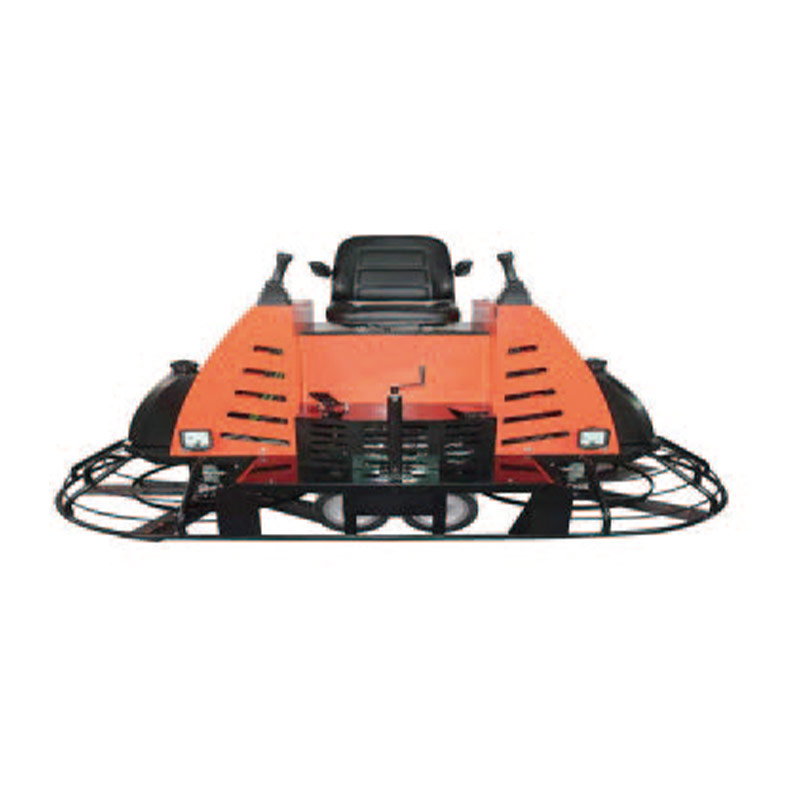
Calculate Machines Needed for Your Pour
Quickly estimate the number of ride-on trowels required for each finishing phase, from floating to final sealing. Plan for the slower of the two.
Inputs you know:
- AAA = Pour area (ft²)
- TTT = Effective finishing window (hours) — from “ready” to “too hard”
- PPP = Expected productivity (ft²/hr per machine) for your machine class and phase
Machines required:
N=A/T×P
Example:
Area A=30,000A = 30,000A=30,000 ft²
Time window T=2.5 hr
Dual-46″ finish productivity P=6,500P = 6,500P=6,500 ft²/hr
N=(30,000/2.5×6,500)=(30,000/16,250)=(1.85)=2 ride-ons (plus a walk-behind for edges)
Pro tip: many crews stage one additional ride-on as a contingency when weather or set times are unpredictable.
Hydrostatic or Mechanical?
Choose hydrostatic when:
- You’re targeting high FF/FL values over large, open slabs
- Operators want ultra-smooth control to avoid swirl marks and overwork
- You’re frequently switching between float and finish speeds
Choose mechanical when:
- Budget is tight and floor geometry is complex (parking decks, column forests)
- You prefer simplified maintenance with fewer hydraulic components
- Your crew already excels with mechanical feel and feedback
Pans, Blades, and Pass Strategy
Pans: Start floating once bleed water is gone and footprints sink ~¼” or less. For big slabs, 11-gauge pans with robust lugs minimize flex and keep consistent contact. Push overlapping lanes by ~6–8″ to avoid ridges.
Blades: Transition to combination or finish blades when the slab supports the machine without tearing. Increase pitch progressively (e.g., from 0–5° at first finish pass to 10–15° for final burn). Keep a matched set across rotors; mismatched wear patterns compromise flatness.
Typical pass sequence (illustrative):
- Float pass 1 (pans, low rpm, low pitch)
- Float pass 2 (pans, slightly higher rpm)
- Finish pass 1 (combo blades, low pitch)
- Finish pass 2 (finish blades, higher pitch for sheen)
- Edge detailing (walk-behind or edging tools as needed)
Crew, Logistics, and Timing
- Crew size: For every ride-on, plan at least one support finisher with a walk-behind or hand tools—especially for perimeters, penetrations, and around columns.
- Staging: Pre-position extra pans/blades, fuel, and lighting. A 5-minute delay multiplied across machines equals lost square footage and missed windows.
- Lighting: Aim for 50–100+ foot-candles for night pours; LED bars on machines reduce eye strain and improve surface read.
- Joints & Edges: Edges often dictate your pace. A strong edge crew prevents bottlenecks that leave the interior over- or under-worked.
Total Cost of Ownership (TCO): What to Watch
- Acquisition: Hydrostatic 46″ class machines typically cost more than mechanical peers.
- Consumables: Pans and blades are your recurring costs—budget based on the number of passes and slab abrasiveness.
- Fuel: Diesel can be more economical for long, steady loads; LPG can cut ventilation costs indoors.
- Maintenance: Belts, filters, hydraulic fluid, pitch mechanisms, and spider assemblies.
- Resale: Reputable brands with service records retain value; hours and rotor integrity drive resale pricing.
TCO Snapshot Table (Illustrative 3-Year View per Machine)
| Cost Component | Dual 36″ | Dual 46″ Hydro | Heavy 60″+ |
| Purchase Price (USD) | $14k–$22k | $26k–$45k | $45k–$75k |
| Annual Maintenance (parts/fluids) | $700–$1,200 | $1,000–$1,800 | $1,500–$2,500 |
| Consumables (pans/blades/year)* | $1,000–$2,000 | $1,500–$3,000 | $2,500–$4,000 |
| Fuel & Ventilation** | $1,800–$3,000 | $2,200–$3,800 | $3,500–$5,500 |
| Estimated 3-Year Resale | 45–55% | 50–60% | 50–60% |
Highly sensitive to pass count and slab abrasiveness.
Assumes moderate utilization; diesel usually lower $/hp-hr, LPG reduces ventilation needs.
Safety, Compliance, and Operator Training
- CO/NOx: For interior pours, monitor air quality. Choose LPG or ensure aggressive ventilation.
- Guards & Deadman: Verify that rotor guards, seat switches, and E-stop work before each shift.
- Lockout/Tagout (LOTO): For maintenance and blade swaps.
- PPE: Eye/ear protection, gloves, high-grip boots.
- Training: Operators should practice controlled starts/stops, consistent overlap, and graduated pitch adjustments. A well-trained operator is often worth more than upgrading one machine class.
Environmental & Mix Considerations
- Hot, dry, windy: Short finishing window; consider adding set-retarding admixture, sunshades, misting, or one extra ride-on.
- Cool, humid: Longer window; heavier machines help close and densify.
- Hard aggregate mixes: Increase blade wear; stock extras.
- Low-slump, low-bleed mixes: Heavier machines and precise timing; avoid early pan marks by testing with foot traffic first.
What to Ask Before You Buy
- Proof of productivity: Request demo or field references with slab size, passes, and FF/FL results.
- Service network: Turnaround on common failures (belts, hoses, pumps, pitch assemblies).
- Parts availability: Pans, blades, spiders, bearings in local stock?
- Warranty terms: Powertrain, hydraulics, labor coverage.
- Ergonomics: Operator fit, sightlines, vibration levels, lighting.
- Telemetry/Hour Meter: Useful for maintenance scheduling and resale value.
Sample Shortlist: Matching Machines to Use-Case
| Use-Case | Primary Machine | Support Machine | Why This Works |
| 25,000 ft² retail slab, columns every 30 ft | Dual 46″ hydro | Dual 36″ mechanical | 46″ covers main lanes quickly; 36″ navigates tighter column grids |
| 50,000 ft² warehouse bay, open plan | Heavy 60″+ diesel | Dual 46″ hydro | Heavy machine for long, straight runs; 46″ handles edges/joints |
| 12,000 ft² parking deck level | Dual 36″ mechanical | Walk-behinds (2x) | Lighter machines reduce edge spalling risk; faster in tight lanes |
| 18,000 ft² interior with vent limits | Dual 46″ LPG | Dual 36″ LPG | Emissions control; maintain throughput while complying with air limits |
Pre-Pour Planning Template
- Area & sequence: Segment the slab into lanes matched to your ride-on path width.
- Machine staging: Fuel, spare pans/blades, tool kits positioned at mid-run.
- Lighting plan: Check for shadows that hide sheen or streaks.
- Roles: Assign operators by phase (float captain, finish captain) and support edges crew.
- Timing triggers: Agree on hand-feel and sheen cues for each pass transition.
- Contingency: One backup machine or rental on call if weather flips the set time.
Putting It All Together: A Realistic Scenario
Scenario: 36,000 ft² distribution center bay, target FF 55 / FL 35, open floor, nighttime pour in warm/dry conditions.
Plan:
- 1× heavy 60″+ diesel ride-on (lead)
- 1× dual-46″ hydro ride-on (follow)
- 2× walk-behinds for edges/joints
Expected throughput:
- Float: heavy 60″+ at ~12,000 ft²/hr + 46″ at ~9,500 ft²/hr in adjacent lanes
- Finish: pace to slower machine—assume ~7,500 ft²/hr (46″ class)
Window: Concrete expected to go from float-ready to finish-hard in ~3 hours; two ride-ons cover (7,500+9,000)(7,500 + 9,000)(7,500+9,000) ft²/hr during float, then ~7,500–8,000 ft²/hr finishing.
Outcome: Adequate capacity with a buffer for weather swings; high-FF achievable with hydrostatic precision and heavy down-pressure where appropriate.
Final Buying Recommendations
- Start with the slab, not the catalog. Define area, time window, environment, and FF/FL targets first.
- Size to your slowest phase. Finishing generally governs machine count; calculate NNN with realistic productivity.
- Choose control feel for your crew. Hydrostatic yields smoother finishes and easier FF/FL control; mechanical can be ideal where budget and simplicity rule.
- Don’t skimp on consumables. Fresh pans and matched blades often matter more than +10 hp on paper.
- Plan the edges. Your ride-on is only as fast as your edge crew lets it be.
- Service wins schedules. Favor brands/dealers with parts on the shelf and fast field support.
At-a-Glance Data Table
| Decision Factor | What to Look For | Why It Matters | Practical Target for Large Pours |
| Coverage Width | 92–100″+ for 46″ class; 120″+ for heavy class | Fewer lanes, faster schedule | Choose the widest machine you can maneuver |
| Power (hp) | 30–55 hp (46″); 55–80+ hp (heavy) | Maintains rpm at higher blade pitch | Avoid power sag during final seal |
| Drive | Hydrostatic for high FF/FL | Fine control at variable speeds | Hydro for open slabs; mechanical for tight decks |
| Weight | 1,000–1,500 lb (46″); 1,800–2,800 lb (heavy) | Down-pressure for densification | Heavier for cool/slow sets; lighter for hot/fast sets |
| Fuel | LPG indoors, diesel for long runs | Emissions & runtime | Match to ventilation and runtime needs |
| Lighting | Integrated LEDs | Night pours & sheen reading | 50–100+ fc at surface |
| Maintenance Access | Tool-less panels, common filters | Downtime kills FF/FL | <15 min pan/blade swap |
| Consumables | 11-gauge pans, matched blades | Consistency across passes | Keep a spare set per machine |
Choosing the right ride-on trowel is less about chasing the biggest spec and more about balancing path width, control, and timing for your slab. Start with the pour size and finishing window, pick the machine class that meets your finishing throughput, and round out the kit with the correct pans, blades, and a disciplined pass strategy. With a well-matched pair—often a dual-46″ hydro plus either a support 36″ or a heavy 60″+—you’ll finish faster, flatter, and with fewer surprises.

